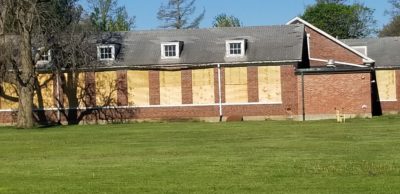The City of Jacksonville has authorized an engineer firm to seek a federal grant to help clean up troublesome properties in the corporate limits.
The city is seeking a Brownfields Assessment Grant with the U.S. Environmental Protection Agency. A brownfield is a designated property that with the expansion, redevelopment, or reuse of which may be complicated by the presence or potential presence of a hazardous substance, pollutant, or contaminant.
The city executed an agreement with engineering firm Fehr Graham in hopes that properties like the current issues at the Lair Building, the old Norris Hospital, or JDC could be set on a path to redevelopment. Principal Engineer Joel Zirkle of Fehr Graham explains what the steps are when it comes to getting the grant: “There are a lot of communities, not only in Illinois but throughout the Midwest and country quite frankly, where there are abandoned properties or under utilized properties and we find that the unknown about the environmental condition of these properties becomes a real inhibitor to attract private investment. The whole purpose of this grant and the reason the US EPA created it in the first place was to provide communities with a resource for them to address those very types of properties.
“As far as JDC goes, one of the concerns that was expressed is would these federal funds be eligible to be expended on that property? That’s one of those things through our contacts and our relationships with the U.S. EPA we were able to confirm that yes indeed these funds could be used, and that would arm the city with some valuable information as to what is the environmental condition of that campus as well as other properties inside the corporate boundary so that plans can be made to revitalize those properties and get them into their highest and best use.”
Zirkle says the grant accounts for allowing the city to inventory the number of properties that are considered a “brownfield,” prioritize which ones need immediate rehabilitation, assess exactly what the problems are, have the U.S. EPA test for levels of any existing contamination and what type of contamination it is, and then, come up with both the costs and plans for remediation to return those properties to best use.
In the case of Norris Hospital, Zirkle says the city would only need cooperation from the owner to carry out the different levels of the grant: “All we need is cooperation from the private property owner. A lot of times what we find is in situations like this, the property owner simply just does not have the means to do what they originally planned. They bought a problem because they didn’t understand how much asbestos or whatever other condition that property is in. This is a way to work collaboratively with that property owner. It’s not to kick them out. It’s not to allow them to simply divest themselves of the property unless that is something that they would like to do, but it helps identify the issues, quantify it – What is the cost? – and then what are the opportunities to help address those issues.”
Zirkle says that sometimes these grants take a long time to process and this is a marathon more than a sprint to the finish when it comes to securing the grant and then beginning the work on the properties. Zirkle says that by starting the process, it will eventually lead to the cleaning up and reinvesting in these properties which ultimately protects the environment, reduces blight, and takes development pressures off greenspaces and working lands.




